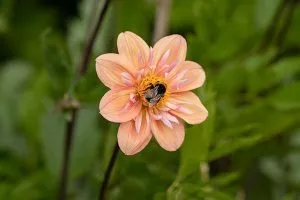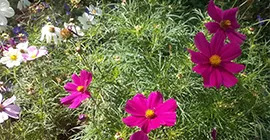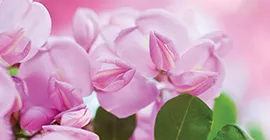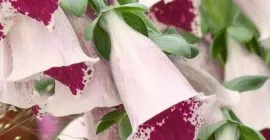Once the weather starts to warm up in February & March, it is a great time to start planting dahlia tubers and sowing seeds for a dazzling display throughout summer and autumn. In this article we will take you through how to grow dahlias including how and when to sow and plant.
Dahlias are benefiting from a revived trend with their fun and impressive decorative heads, spiky petals and round pom-pom like features that come in a plethora of colours from bright reds to pastel pinks. They last really well as cut flowers too and have earned lots of enthusiastic fans.
They require rich organic matter mixed into the soil and are thirsty plants that need well watering in a prolonged dry spell, but do well in sunny spots.
Our Favourites
‘David Howard’ – Miniature with orange flowers and dark purple-bronzed foliage. Height 100cm
‘Bishop’s Children’ – prettily dissected bronze foliage single flowers in mainly reds, oranges, yellows and gold. Perfect for borders. Height 1m
‘Dandy’ – a bold blend of contrasting colours on main petals with a ring of shorter petals around the eye. Height 60cm
‘Ambition’ – bright purple spikey cactus like petals. Height 1m
‘Con Amore’ – magenta crimson red petals. Height 1m
‘Downham Royal’ – small neat ball flower head in a rich purple. Height 1.1m
‘Thomas A. Edison’ – large flower heads in a dark shade of purple. Height 1m
‘Sam Hopkins’ –A rich dark red with almost black velvety centre. Height 1m
‘Jescot Julie’ – warm shades of apricot, yellow and red, double flowered petals. Height 40cm
‘Jowey Mirella’ – a neat ball flower head in bold chocolaty claret colour. Height 1m

How to Grow Dahlias
When to sow?
Bedding Dahlias which last for one season are fairly easy to grow from seed in March to April. You can find annual dahlia seeds in the Unwins collection.
Longer lasting perennial dahlias should be sown in February or March as they need a longer growing season to give them plenty of time to form tubers.
Sowing from seed
Fill a seed tray with seed compost such as Westland John Innes Seed Sowing Compost and firm it down.
Scatter the seeds thinly over the surface and cover lightly with a layer of sieved compost.
Water and allow to drain.
Cover over the seeds tray with a propagator lid, cling film or a sheet of glass and place on a bright windowsill indoors. Alternatively place in a heated propagator.
Ensure you keep the compost moist throughout.
Potting On Seedlings
Prick out the seedlings into individual small pots when they are large enough to handle and grow under cover.
Once their roots start to fill the pots, give them a diluted tomato feed such as Westland Big Tom or a general purpose plant feed such as Westland Boost once a week.
Harden off the young plants thoroughly before planting them outside, these flowers are ideal to plant in beds, borders or large containers around late May.
Planting Dahlia Tubers
Pot up your tubers in a pot with compost in early spring. You should keep these pots protected from frost, either in a greenhouse or growhouse. Make sure to water well and keep somewhere sunny.
Once the risk of frost has passed, you can plant out your dahlia tubers. They will most likely have sprouted little green shoots now and be starting to grow. Find your chosen spot, either in a border or large pot and plant your dahlia just below the surface, with the shoots above ground. Dahlias are hungry plants so you can dig some nutrient rich Farmyard Manure or Growmore into the planting hole to give your plant a good start. Water in well and add a thick layer of mulch over the top.
Shoots can be vunerable to slugs and snails so you can protect your dahlias with slug barrier pellets.
Flowering Period
You should start to get flowers from Mid-July all the way through to November
Care
If you are growing perennial dahlias, they will return year after year. You can leave the tubers in the ground, but this is risky as wet and cold weather can rot and destroy your precious dahlia tubers. It is safer to lift perennial dahlia tubers from the ground.
To do this, once your dahlia has finished flowering in late autumn, cut the stem down to about 5cm and lift the tuber out the ground with a garden fork. Brush off any excess soil and remove any rotten or damaged parts. You will able to tell if the tubers are rotten if they are very soft to the touch. Any of the sausage shaped tubers that can be easy squashed with your fingers are best removed.
Wash your tubers off, allow to dry and then store in a cool, frost-free location, such as a garage or shed. You can store the tubers in sand if you have any. These will then be protected so they can be planted again next year.




